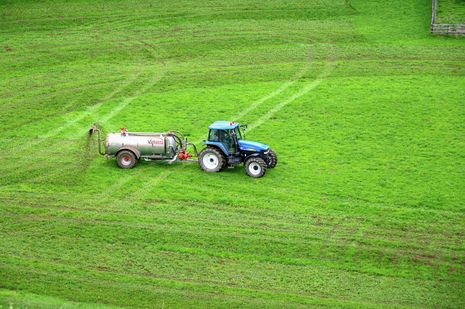We should be worried about soaring fertiliser prices
Rising prices drive unrest and global inequality

Industrially produced fertilisers, often referred to as inorganic fertilisers, are a mainstay of modern farming as they provide key nutrients (particularly nitrogen, phosphorous, and potassium) that crops need to grow. These nutrients are commonly depleted in farmed soils due to repeated cropping and degradation such as by soil erosion, and so farmers rely on their use to maintain productivity. However, prices of these vital resources have hit an all-time high and farmers in the UK and abroad are feeling the squeeze.
Prices of major fertilisers such as ammonium nitrate have jumped 200% compared to 2021, forcing farmers to spend more to grow crops. The present crisis has been brought on by a number of causes, including the war in Ukraine, as Russia, Belarus, and Ukraine are all major exporters. Additionally, rising gas prices due to the war have put further pressure on nitrogen fertilisers, as many are produced via energy intensive methods.
While costs for some fertilisers have begun to level off, phosphate-based fertiliser prices continue to soar. This sharp increase threatens to further inflate food prices, exacerbating the existing cost of living crisis. Many British farmers are finding that fertilisers are becoming prohibitively expensive, with many accusing the government of not doing enough to deal with the problem. While the Department for Environment, Food and Rural Affairs (DEFRA) has held talks with industry leaders, many farmers feel that Boris Johnson does not take the situation seriously.
“Prices of major fertilisers such as ammonium nitrate have jumped 200% compared to 2021”
China, responsible for 30% of the world’s phosphate production, banned the export of fertilisers last year in attempt to combat mounting domestic prices – further spurring on price hikes internationally. Meanwhile, the world’s single biggest fertiliser producer, the Canadian company Nutrien, has struggled to export its product due to rail strikes.
While rich countries are certainly experiencing the effects, the situation is only more pronounced in developing nations. Globally, the access to and use of chemical fertilisers is far from balanced, with many countries experiencing deficits while rich nations apply them in excess. More and more smallholder farmers in developing nations have been priced out, resorting to manure or simply planting without fertilisers.
Some relief has come to Kenyan farmers as the country’s Ministry of Agriculture has invested 5.7 billion shillings (roughly £39 million) to bring prices down. In neighbouring Ethiopia, where ~6.3 million farmers are reliant on subsidised vouchers to receive expensive agricultural inputs like fertiliser, the government has signed a deal with a UAE-based corporation to supply half a million tonnes of urea – albeit still at a high price.
“The crisis shows the need to reduce reliance on inorganic fertilisers”
Not only does it directly impact food and farming, but the price crisis also exacerbates existing political tensions globally. Last month, protests against rising fertiliser and fuel prices in Peru turned violent as police clashed with protestors in an attempt to enforce a curfew. Protests across the country have resulted in at least six deaths since they began as tensions between Peru and its leaders rise.
The events in Peru mirror similar, albeit less violent, protests in Greece in March as well as in Sri Lanka last year where the government in Columbo ended fertiliser subsidies, resulting in great losses for farmers. While this was eventually reversed, Sri Lanka’s current political and economic crisis and intense anti-government protests in the capital mean many farmers still do not have access to the resources they need.
The crisis clearly demonstrates a need to reduce global reliance on inorganic fertilisers in ways that are both sustainable and equitable – particularly for the world’s poorest farmers.
One potential avenue is to promote natural interactions between crops, nutrients, and microorganisms in the soil that improve their uptake. Here in Cambridge, several teams of scientists at the Crop Sciences Centre, a collaboration between the Department of Plant Sciences and The National Institute of Agricultural Botany, are currently working on this.
“We’re really excited by the progress so far,” says Professor Giles Oldroyd, the Centre’s director. “As part of the Engineering Nitrogen Symbiosis for Africa (ENSA) programme, we strive to enhance these beneficial microbial associations to sustainably improve productivity for smallholder farmers in developing countries.”
While research continues to reduce the need for inorganic fertilisers in agriculture, prices remain high and farmers around the world continue to suffer. Ultimately, the situation of global inequality surrounding fertiliser price, access, and use needs to be drastically improved if we are to feed increasing populations in an equitable manner.
 News / Eight Cambridge researchers awarded €17m in ERC research grants27 December 2025
News / Eight Cambridge researchers awarded €17m in ERC research grants27 December 2025 News / Downing investigates ‘mysterious’ underground burial vault 29 December 2025
News / Downing investigates ‘mysterious’ underground burial vault 29 December 2025 Lifestyle / Ask Auntie Alice29 December 2025
Lifestyle / Ask Auntie Alice29 December 2025 Sport / Hard work, heartbreak and hope: international gymnast Maddie Marshall’s journey 29 December 2025
Sport / Hard work, heartbreak and hope: international gymnast Maddie Marshall’s journey 29 December 2025 News / News in Brief: carols, card games, and canine calamities28 December 2025
News / News in Brief: carols, card games, and canine calamities28 December 2025








